RENAULT SCENIC 2009 J84 / 2.G Engine And Peripherals EDC16 Manual Online
Manufacturer: RENAULT, Model Year: 2009, Model line: SCENIC, Model: RENAULT SCENIC 2009 J84 / 2.GPages: 273
Page 81 of 273
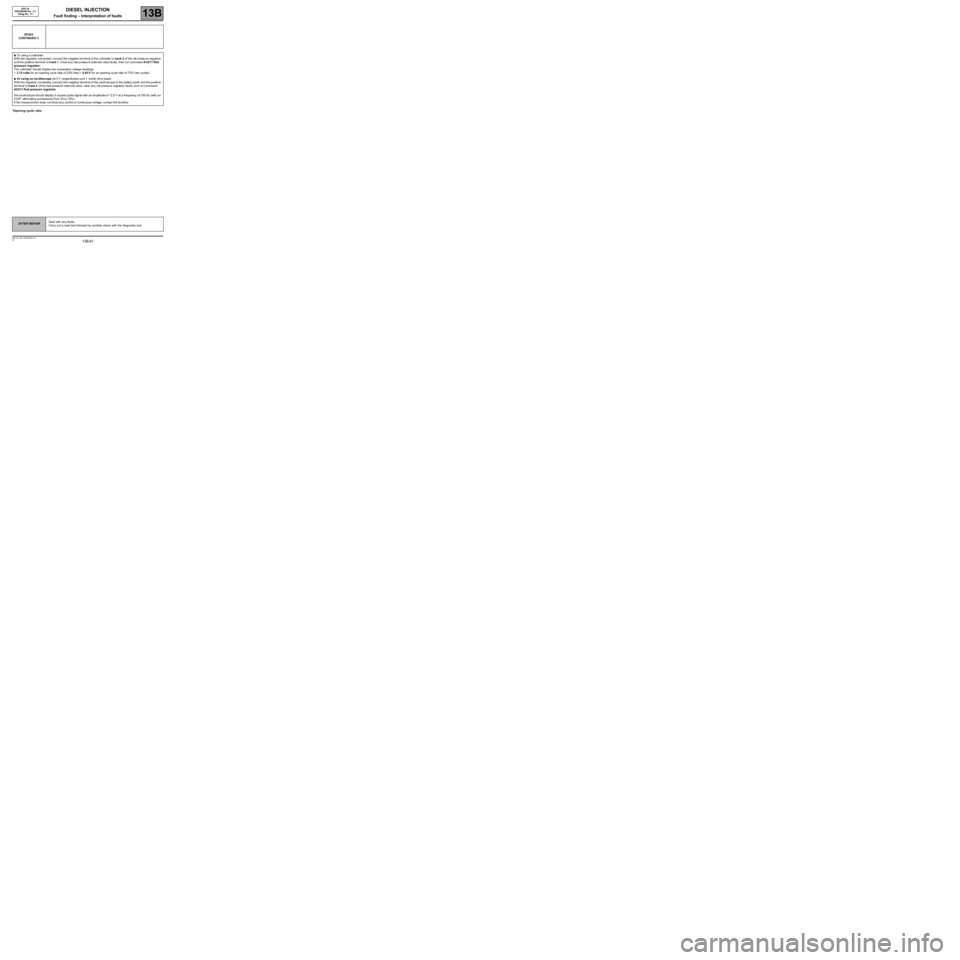
DIESEL INJECTION
Fault finding – Interpretation of faults13B
13B-81V3 MR-372-J84-13B250$360.mif
AFTER REPAIRDeal with any faults.
Carry out a road test followed by another check with the diagnostic tool.
EDC16
PROGRAM No.: C1
Vdiag No.: 51
*Opening cyclic ratioDF053
CONTINUED 3
●Or usingavoltmeter:
With the regulator connected, connect the negative terminal of the voltmeter totrack 2of the rail pressure regulator
and thepositive terminal totrack 1.Clear any fuel pressure solenoid valve faults, then run commandAC011 Rail
pressure re gulator:
Thevoltmeter should display two successive voltage readings:
~3.15voltsfor an opening cycle ratio of 25% then~9.45Vfor an opening cycle ratio of 75% (ten cycles).
●Or using an oscillos cope(at 5 V range/division a nd 1 ms/div tim e base):
With the regulator connected, connect the negative terminal of the oscill oscope to the battery earth and the positive
terminal totrack 2of the fuel pressure solenoid valve, clear any r ail pressure regulator faults, and r un command
AC0 11 R ail pressure regulator:
theoscillo sco pe sh ould disp lay a square pulse signal with an a mplitude o f 1 2.5 V at a frequency of 1 85 Hz (with a n
OCR* alternating successively from 25 to 75%).
if the measurement does not show any control or continuous voltage, contact the techline.
Page 82 of 273
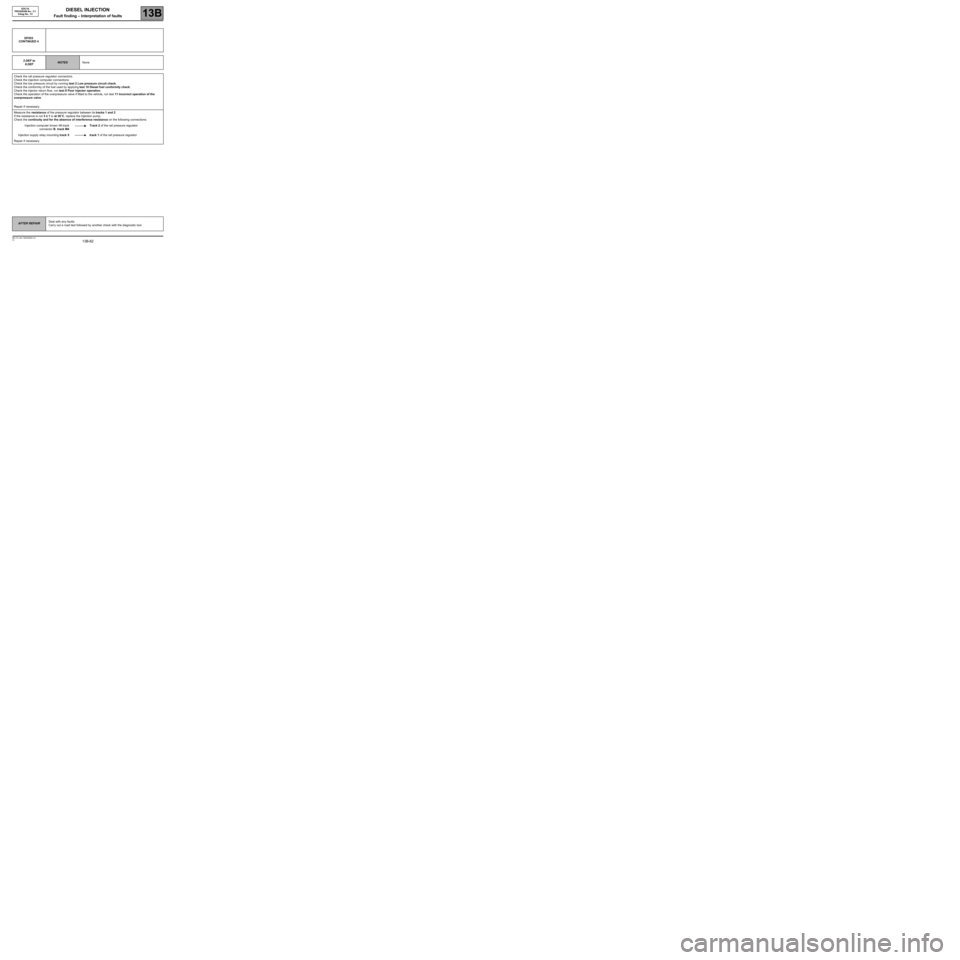
DIESEL INJECTION
Fault finding – Interpretation of faults13B
13B-82V3 MR-372-J84-13B250$360.mif
DF053
CONTINUED 4
2.DEF to
8.DEF
NOTESNone
Check the rail pressure regulator connectors.
Check the injection computer connections.
Check the low pressure circuit by running test 2 Low pressure circuit check.
Check the conformity of the fuel used by applying test 10 Diesel fuel conformity check.
Check the injector return flow, run test 8 Poor injector operation.
Check the operation of the overpressure valve if fitted to the vehicle, run test 11 Incorrect operation of the
overpressure valve.
Repair if necessary.
Measure the resistance of the pressure regulator between its tracks 1 and 2.
If the resistance is not 3 ± 1 Ω at 20˚C, replace the injection pump.
Check the continuity and for the absence of interference resistance on the following connections:
Injection computer brown 48-track
connector B, track M4Track 2 of the rail pressure regulator
Injection supply relay mounting track 5 track 1 of the rail pressure regulator
Repair if necessary.
AFTER REPAIRDeal with any faults.
Carry out a road test followed by another check with the diagnostic tool.
EDC16
PROGRAM No.: C1
Vdiag No.: 51
Page 83 of 273
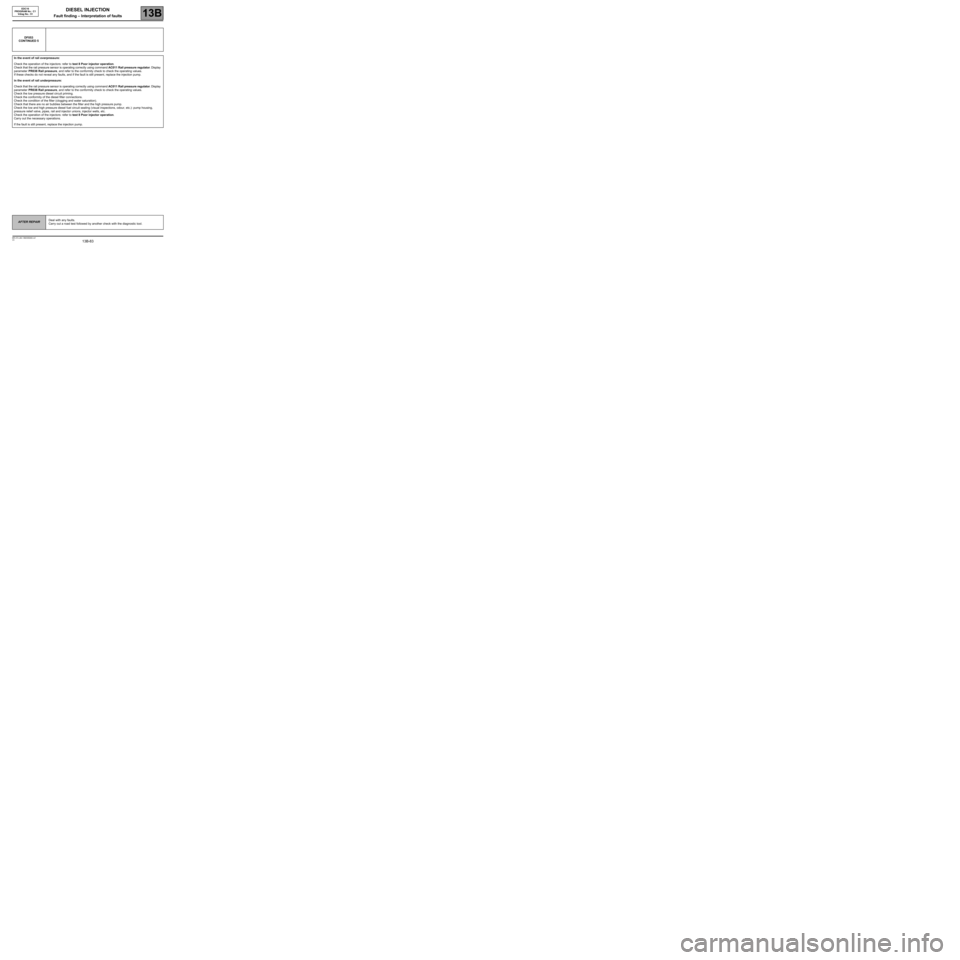
DIESEL INJECTION
Fault finding – Interpretation of faults13B
13B-83V3 MR-372-J84-13B250$360.mif
EDC16
PROGRAM No.: C1
Vdiag No.: 51
DF053
CONTINUED 5
In the event of rail overpressure:
Check the operation of the injectors: refer to test 8 Poor injector operation.
Check that the rail pressure sensor is operating correctly using command AC011 Rail pressure regulator. Display
parameter PR038 Rail pressure, and refer to the conformity check to check the operating values.
If these checks do not reveal any faults, and if the fault is still present, replace the injection pump.
in the event of rail underpressure:
Check that the rail pressure sensor is operating correctly using command AC011 Rail pressure regulator. Display
parameter PR038 Rail pressure, and refer to the conformity check to check the operating values.
Check the low pressure diesel circuit priming.
Check the conformity of the diesel filter connections.
Check the condition of the filter (clogging and water saturation).
Check that there are no air bubbles between the filter and the high pressure pump.
Check the low and high pressure diesel fuel circuit sealing (visual inspections, odour, etc.): pump housing,
pressure relief valve, pipes, rail and injector unions, injector wells, etc.
Check the operation of the injectors: refer to test 8 Poor injector operation.
Carry out the necessary operations.
If the fault is still present, replace the injection pump.
AFTER REPAIRDeal with any faults.
Carry out a road test followed by another check with the diagnostic tool.
Page 84 of 273

DIESEL INJECTION
Fault finding – Interpretation of faults13B
13B-84V3 MR-372-J84-13B250$360.mif
EDC16
PROGRAM No.: C1
Vdiag No.: 51
DF054
PRESENT
OR
STORED
TURBOCHARGING SOLENOID VALVE CONTROL CIRCUIT
CC.1 : Short circuit to + 12 V
CC.0 : Short circuit to earth
CO : Open circuit
1.DEF : Internal electronic fault
2.DEF : Inconsistent signal
3.DEF : Below minimum threshold
4.DEF : Above maximum threshold
5.DEF : Permanent high signal
NOTESConditions for applying the fault finding procedure to stored faults:
The fault is declared present after:
–the engine is started,
–a road test,
–actuator command AC004 Turbocharging solenoid valve.
Special notes:
If the fault is present:
–turbocharging is no longer authorised,
–the EGR function is inhibited,
–the vehicle performance is reduced,
–the level 1 warning light is lit,
–If CC.0 is present, the OBD warning light will come on after three consecutive driving
cycles (starting + 5 seconds + switching off the ignition and waiting for 1 minute).
Use bornier Ele. 1681 or Ele. 1590 for any operation on the injection computer
connectors.
CC.1
4.DEF
5.DEF
NOTESNone
Check the turbocharging solenoid valve connections.
Check the injection computer connections.
Repair if necessary.
Measure the resistance of the turbocharging solenoid valve between tracks 1 and 2:
If the resistance displayed is not 15.4 ± 0.7 Ω at 20˚C, replace the turbocharger solenoid valve.
Check the continuity and insulation from the + 12 V feed of the following connection:
Injection computer grey 32-track connector C,
track E1Track 1 turbocharging solenoid valve
Repair if necessary.
If the fault is still present, replace the turbocharging solenoid valve.
AFTER REPAIRDeal with any faults.
Carry out a road test followed by another check with the diagnostic tool.
EDC16_V51_DF054
Page 85 of 273
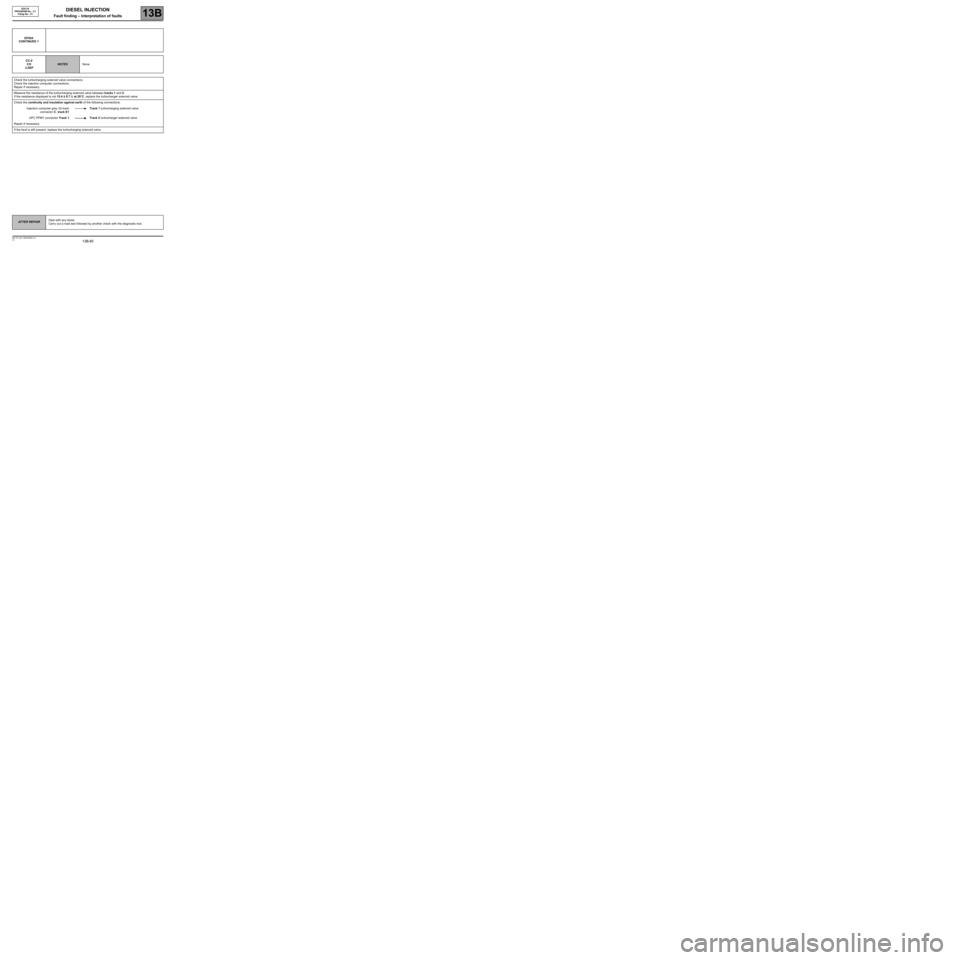
DIESEL INJECTION
Fault finding – Interpretation of faults13B
13B-85V3 MR-372-J84-13B250$360.mif
EDC16
PROGRAM No.: C1
Vdiag No.: 51
DF054
CONTINUED 1
CC.0
CO
3.DEF
NOTESNone
Check the turbocharging solenoid valve connections.
Check the injection computer connections.
Repair if necessary.
Measure the resistance of the turbocharging solenoid valve between tracks 1 and 2:
If the resistance displayed is not 15.4 ± 0.7 Ω at 20˚C, replace the turbocharger solenoid valve.
Check the continuity and insulation against earth of the following connections:
Injection computer grey 32-track
connector C, track E1Track 1 turbocharging solenoid valve
UPC PPM1 connector Track 1 Track 2 turbocharger solenoid valve
Repair if necessary.
If the fault is still present, replace the turbocharging solenoid valve.
AFTER REPAIRDeal with any faults.
Carry out a road test followed by another check with the diagnostic tool.
Page 86 of 273
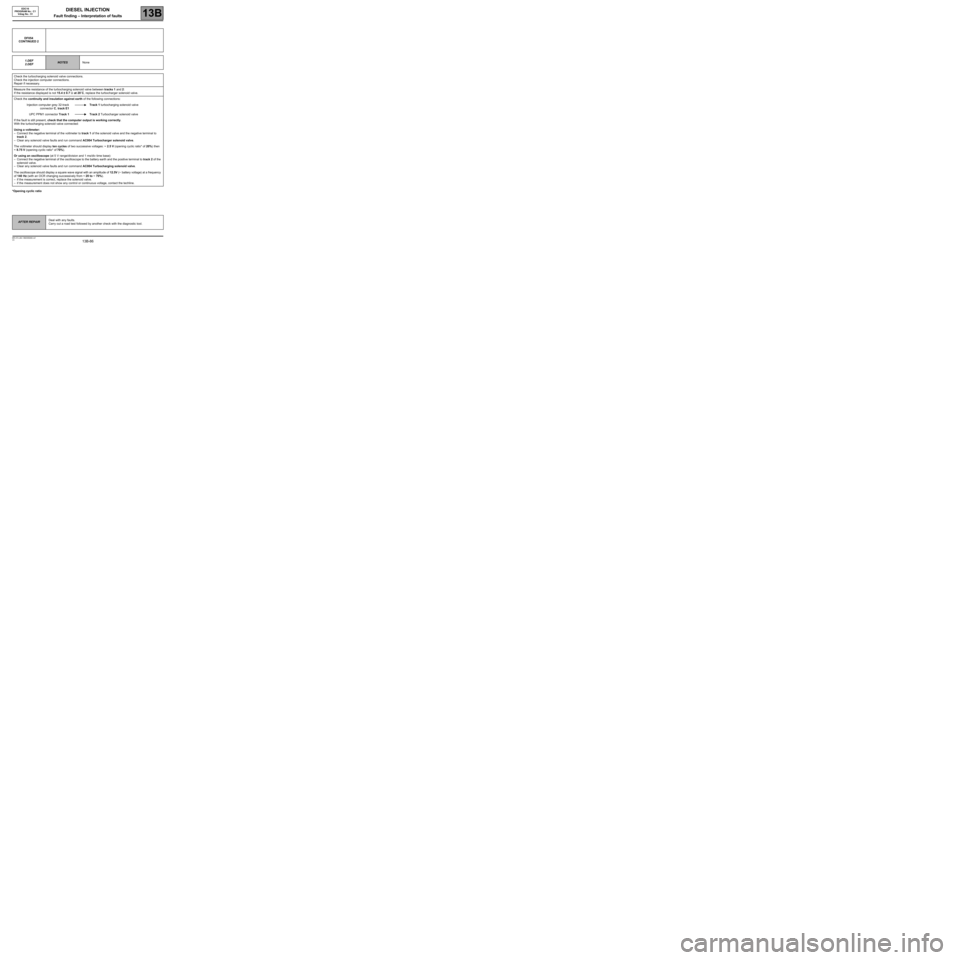
DIESEL INJECTION
Fault finding – Interpretation of faults13B
13B-86V3 MR-372-J84-13B250$360.mif
EDC16
PROGRAM No.: C1
Vdiag No.: 51
*Opening cyclic ratioDF054
CONTINUED 2
1.DEF
2.DEF
NOTESNone
Check the turbocharging solenoid valve connections.
Check the injection computer connections.
Repair if necessary.
Measure the resistance of the turbocharging solenoid valve between tracks 1 and 2:
If the resistance displayed is not 15.4 ± 0.7 Ω at 20˚C, replace the turbocharger solenoid valve.
Check the continuity and insulation against earth of the following connections:
Injection computer grey 32-track
connector C, track E1Track 1 turbocharging solenoid valve
UPC PPM1 connector Track 1 Track 2 Turbocharger solenoid valve
If the fault is still present, check that the computer output is working correctly.
With the turbocharging solenoid valve connected:
Using a voltmeter:
–Connect the negative terminal of the voltmeter to track 1 of the solenoid valve and the negative terminal to
track 2.
–Clear any solenoid valve faults and run command AC004 Turbocharger solenoid valve.
The voltmeter should display ten cycles of two successive voltages: ~ 2.5 V (opening cyclic ratio* of 20%) then
~ 8.75 V (opening cyclic ratio* of 70%).
Or using an oscilloscope (at 5 V range/division and 1 ms/div time base):
–Connect the negative terminal of the oscilloscope to the battery earth and the positive terminal to track 2 of the
solenoid valve.
–Clear any solenoid valve faults and run command AC004 Turbocharging solenoid valve.
The oscilloscope should display a square wave signal with an amplitude of 12.5V (~ battery voltage) at a frequency
of 140 Hz (with an OCR changing successively from ~ 20 to ~ 70%).
–if the measurement is correct, replace the solenoid valve.
–if the measurement does not show any control or continuous voltage, contact the techline.
AFTER REPAIRDeal with any faults.
Carry out a road test followed by another check with the diagnostic tool.
Page 87 of 273
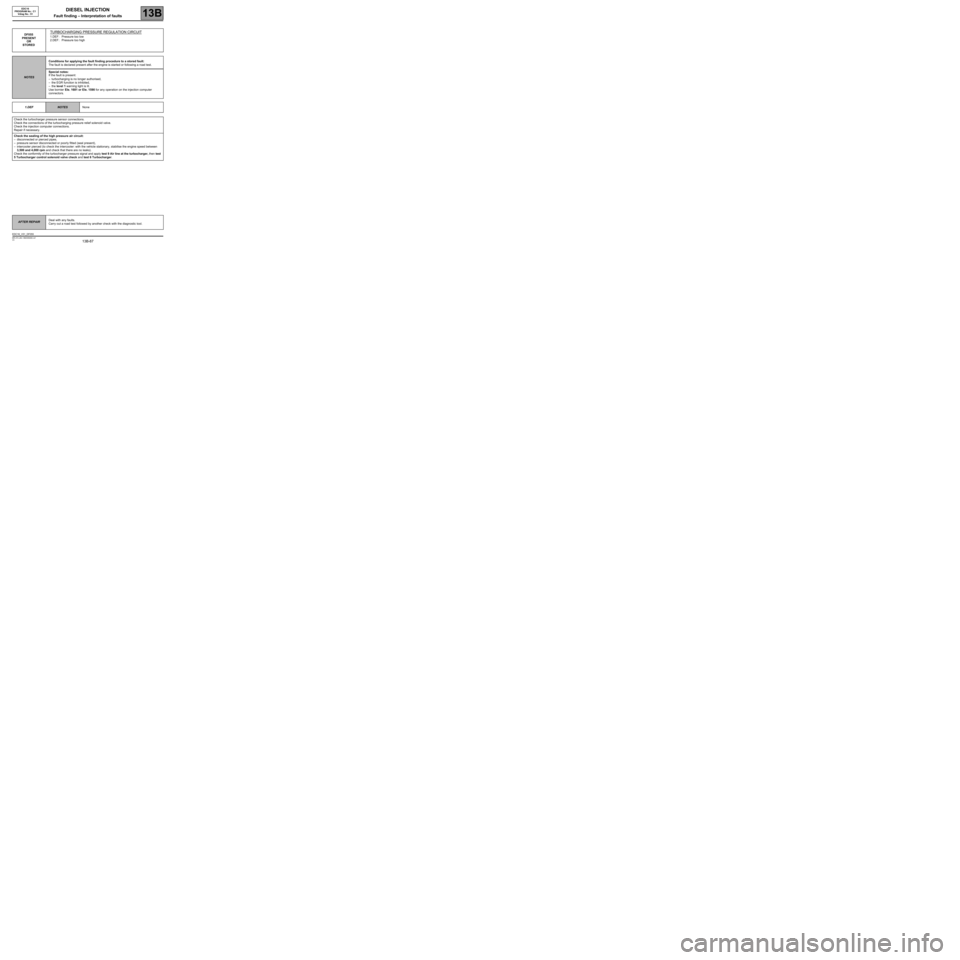
DIESEL INJECTION
Fault finding – Interpretation of faults13B
13B-87V3 MR-372-J84-13B250$360.mif
EDC16
PROGRAM No.: C1
Vdiag No.: 51
DF055
PRESENT
OR
STOREDTURBOCHARGING PRESSURE REGULATION CIRCUIT
1.DEF : Pressure too low
2.DEF : Pressure too high
NOTESConditions for applying the fault finding procedure to a stored fault:
The fault is declared present after the engine is started or following a road test.
Special notes:
If the fault is present:
–turbocharging is no longer authorised,
–the EGR function is inhibited,
–the level 1 warning light is lit.
Use bornier Ele. 1681 or Ele. 1590 for any operation on the injection computer
connectors.
1.DEF
NOTESNone
Check the turbocharger pressure sensor connections.
Check the connections of the turbocharging pressure relief solenoid valve.
Check the injection computer connections.
Repair if necessary.
Check the sealing of the high pressure air circuit:
–disconnected or pierced pipes,
–pressure sensor disconnected or poorly fitted (seal present),
–intercooler pierced (to check the intercooler: with the vehicle stationary, stabilise the engine speed between
3,500 and 4,000 rpm and check that there are no leaks).
Check the conformity of the turbocharger pressure signal and apply test 9 Air line at the turbocharger, then test
5 Turbocharger control solenoid valve check and test 6 Turbocharger.
AFTER REPAIRDeal with any faults.
Carry out a road test followed by another check with the diagnostic tool.
EDC16_V51_DF055
Page 88 of 273
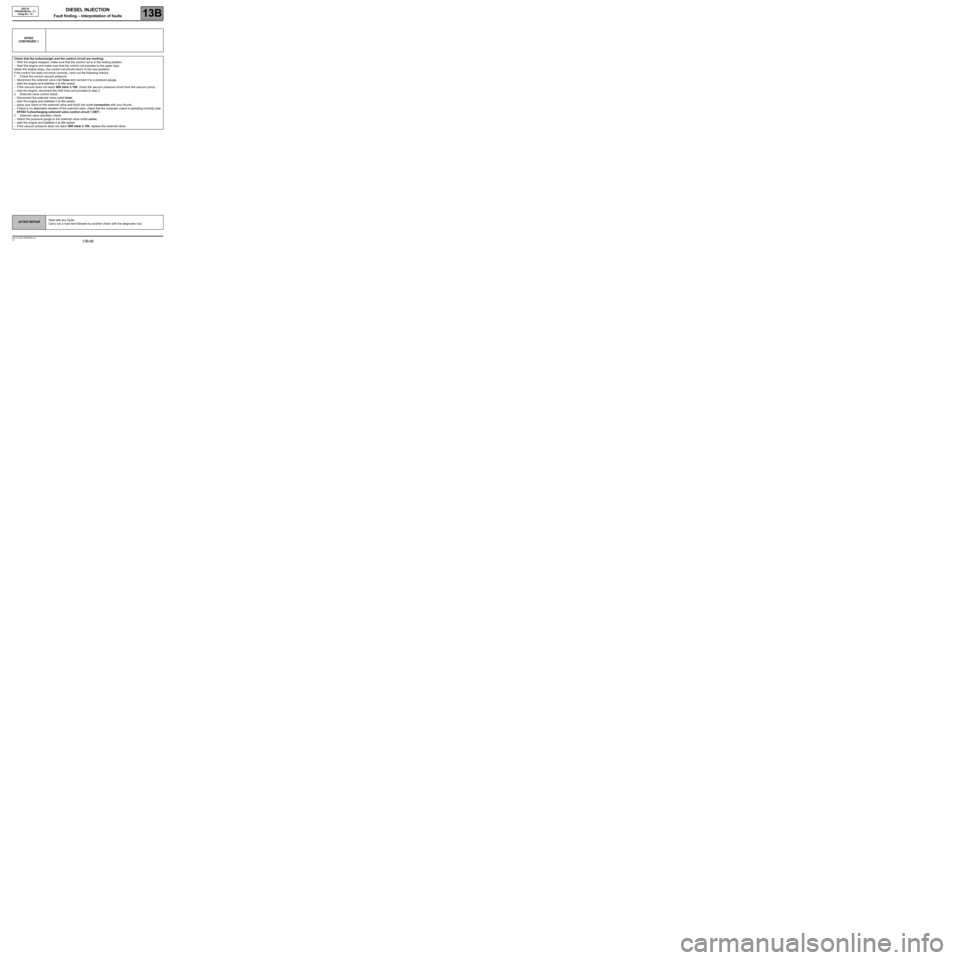
DIESEL INJECTION
Fault finding – Interpretation of faults13B
13B-88V3 MR-372-J84-13B250$360.mif
EDC16
PROGRAM No.: C1
Vdiag No.: 51
DF055
CONTINUED 1
Check that the turbocharger and the control circuit are working:
–With the engine stopped, make sure that the control rod is in the resting position.
–Start the engine and make sure that the control rod actuates to the upper stop.
(when the engine stops, the control rod should return to the rest position).
If the control rod does not move correctly, carry out the following checks:
1Check the control vacuum pressure:
–disconnect the solenoid valve inlet hose and connect it to a pressure gauge,
–start the engine and stabilise it at idle speed,
–If the vacuum does not reach 800 mbar ± 100: check the vacuum pressure circuit from the vacuum pump,
–stop the engine, reconnect the inlet hose and proceed to step 2.
2Solenoid valve control check:
–Disconnect the solenoid valve outlet hose,
–start the engine and stabilise it at idle speed,
–place your hand on the solenoid valve and block the outlet connection with your thumb,
–if there is no detectable vibration of the solenoid valve, check that the computer output is operating correctly (see
DF054 Turbocharging solenoid valve control circuit 1.DEF).
3Solenoid valve operation check:
–Attach the pressure gauge to the solenoid valve outlet union,
–start the engine and stabilise it at idle speed,
–if the vacuum pressure does not reach 800 mbar ± 100, replace the solenoid valve.
AFTER REPAIRDeal with any faults.
Carry out a road test followed by another check with the diagnostic tool.
Page 89 of 273
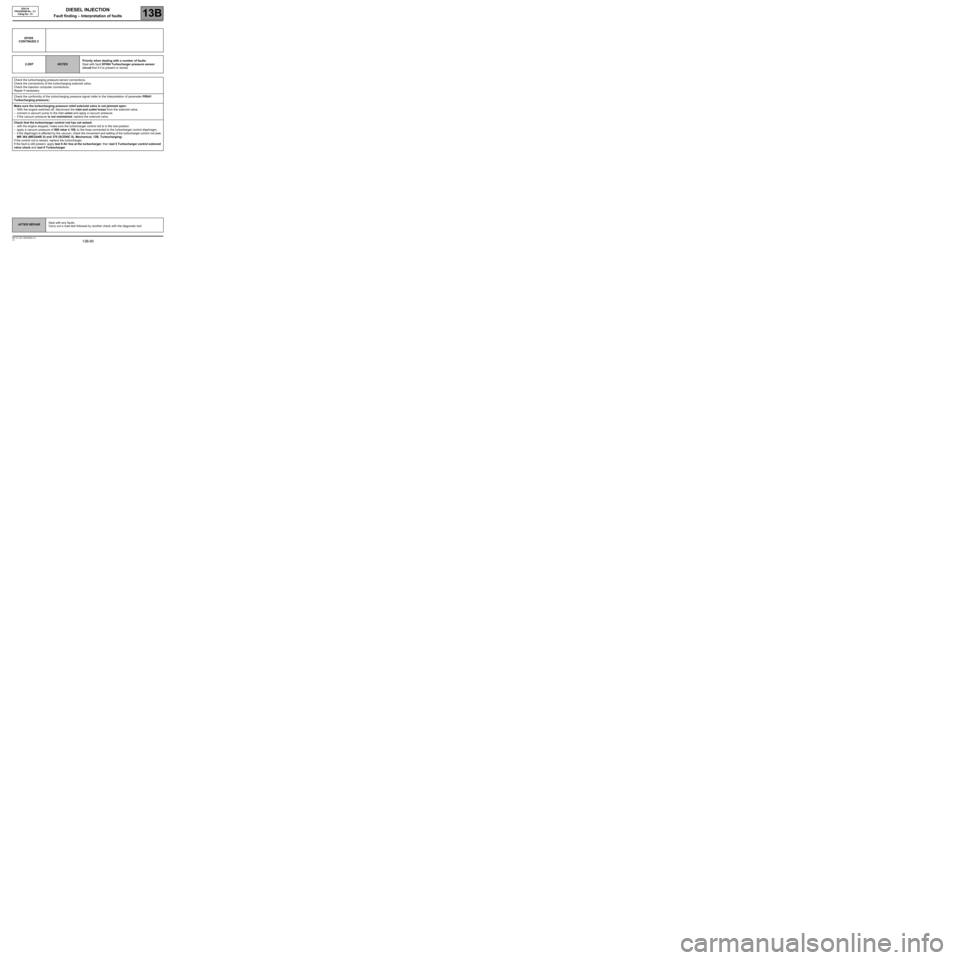
DIESEL INJECTION
Fault finding – Interpretation of faults13B
13B-89V3 MR-372-J84-13B250$360.mif
EDC16
PROGRAM No.: C1
Vdiag No.: 51
DF055
CONTINUED 2
2.DEF
NOTESPriority when dealing with a number of faults:
Deal with fault DF004 Turbocharger pressure sensor
circuit first if it is present or stored.
Check the turbocharging pressure sensor connections,
Check the connections of the turbocharging solenoid valve,
Check the injection computer connections.
Repair if necessary.
Check the conformity of the turbocharging pressure signal (refer to the interpretation of parameter PR041
Turbocharging pressure).
Make sure the turbocharging pressure relief solenoid valve is not jammed open:
–With the engine switched off, disconnect the inlet and outlet hoses from the solenoid valve.
–connect a vacuum pump to the inlet union and apply a vacuum pressure.
–if the vacuum pressure is not maintained: replace the solenoid valve.
Check that the turbocharger control rod has not seized:
–with the engine stopped, make sure the turbocharger control rod is in the rest position.
–apply a vacuum pressure of 800 mbar ± 100, to the hose connected to the turbocharger control diaphragm,
–if the diaphragm is affected by the vacuum, check the movement and setting of the turbocharger control rod (see
MR 364 (MEGANE II) and 370 (SCENIC II), Mechanical, 12B, Turbocharging).
If the control rod is seized, replace the turbocharger.
If the fault is still present, apply test 9 Air line at the turbocharger, then test 5 Turbocharger control solenoid
valve check and test 6 Turbocharger.
AFTER REPAIRDeal with any faults.
Carry out a road test followed by another check with the diagnostic tool.
Page 90 of 273

DIESEL INJECTION
Fault finding – Interpretation of faults13B
13B-90V3 MR-372-J84-13B250$405.mif
EDC16
PROGRAM No.: C1
Vdiag No.: 51DIESEL INJECTION
Fault finding – Interpretation of faults
DF056
PRESENT
OR
STOREDAIR FLOWMETER CIRCUIT
CC.1 : Short circuit to + 12 V
CO.0 : Open circuit or short circuit to earth
1.DEF : Offset at maximum threshold
2.DEF : Offset at minimum threshold
NOTESConditions for applying the fault finding procedure to a stored fault:
The fault is declared present after a road test.
Special notes:
If the fault is present:
–the level 1 warning light is lit,
–the OBD warning light will come on after three consecutive driving cycles (starting
+ 5 seconds + switching off the ignition and waiting 1 minute).
Use bornier Ele. 1681 or Ele. 1590 for any operation on the injection computer
connectors.
Priorities when dealing with a number of faults:
Deal with fault DF013 Sensor supply voltage no. 3 first, if it is present or stored.
CC.1
NOTESNone
Check the air flowmeter connections.
Check the injection computer connections.
Repair if necessary.
Check the continuity and the insulation to + 12 V of the following connections:
Injection computer brown 48-track connector B, track E2 Track 2 of the air flow sensor
Injection computer brown 48-track connector B, track L4 Track 6 of the air flow sensor
Injection computer brown 48-track connector B, track G1 Track 5 of the air flow sensor
Injection computer brown 48-track connector B, track B4 Track 3 of the air flow sensor
If the fault is still present, replace the air flowmeter.
AFTER REPAIRDeal with any faults.
Carry out a road test followed by another check with the diagnostic tool.
EDC16_V51_DF056